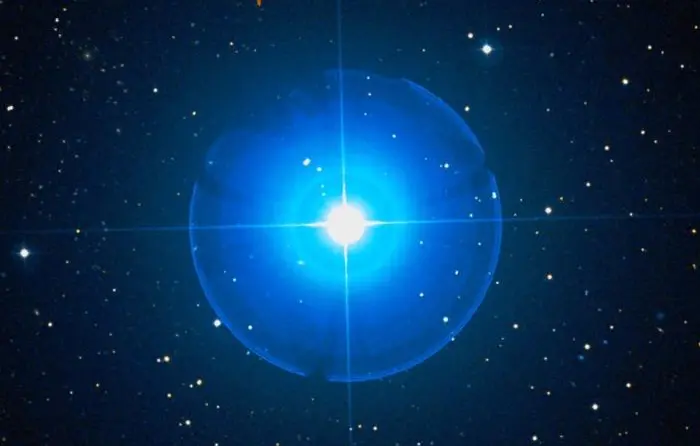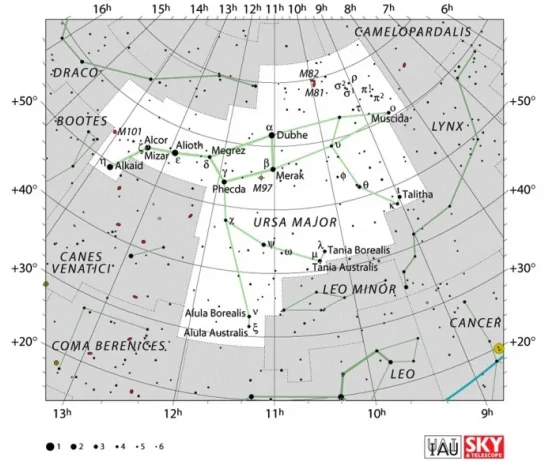Alkaphrah, Kappa Ursae Majoris A (κ UMa A), is the primary component in a binary star system located approximately 360 light-years away in the constellation Ursa Major. It is one of the relatively bright stars that form the feet of the Great Bear and an asterism called the Three Leaps of the Gazelle. The system has a combined apparent magnitude of 3.56 and is visible to the unaided eye.
Star system
Kappa Ursae Majoris is a double star system composed of two A-type main sequence stars of the spectral types A0 IV-V and A0 V. The primary component, Kappa Ursae Majoris A, has a visual magnitude of 4.16 and the companion Kappa Ursae Majoris B shines at magnitude 4.54.
The two components are separated by 0.18 arcseconds and have an orbital period of 35.6 years (13,007.2 days). The system shows an infrared excess, indicating the presence of a debris disk. The disk orbits the primary component at a separation of 55.2 astronomical units and has a mean temperature of 165 K.

Alkaphrah (Kappa Ursae Majoris), image: Wikisky (DSS)
The primary star is formally known as Alkaphrah. It has a mass of around 3.79 solar masses and a radius 7.87 times that of the Sun. The surface temperature of 9,060 K gives it a bluish white glow of an A-type star.
Alkaphrah is an exceptionally fast spinner. With a projected rotational velocity of 201 km/s, it takes only 3.5 days to complete a rotation (compared to the Sun’s 25-day rotation period). Due to its high spin rate, the star has an oblate shape. It is flattened at the poles and has an equatorial bulge.
Facts
Alkaphrah is part of an old Arabic asterism known as the Three Leaps of the Gazelle. The asterism consists of three pairs of stars. Alkaphrah forms the Third Leap with Talitha (Iota Ursae Majoris). The First Leap is formed by Alula Borealis (Nu Ursae Majoris) and Alula Australis (Xi Ursae Majoris), and the Second Leap by Tania Borealis (Lambda Ursae Majoris) and Tania Australis (Mu Ursae Majoris). The six stars mark the feet of Ursa Major, the Great Bear.
In old Arabic astronomy, the stars were collectively known as Kafzah al Thiba’, “the Springs of the Gazelle.” They were part of a larger gazelle figure with the fainter stars of the constellation Leo Minor. In Arabic lore, the Three Leaps asterism represented the leaps of a gazelle that was startled by a lion, represented by the constellation Leo, and dashed across a pond, represented by the stars of the constellation Coma Berenices.

Three Leaps of the Gazelle, image: Stellarium
Name
The name Alkaphrah (pronunciation: /ælˈkæfrə/) comes from the Arabic al-qafzah, meaning “the leap.” It refers to the Three Leaps of the Gazelle asterism, formed by Alkaphrah (Kappa UMa), Talitha (Iota UMa), Tania Borealis (Lambda UMa), Tania Australis (Mu UMa), Alula Borealis (Nu UMa), and Alula Australis (Xi UMa). Alkaphrah and Talitha form the Third Leap. The names of all six stars are derived from the Arabic names of the asterism.
Talitha and Alkaphrah were historically also known as Talitha Borealis and Talitha Australis. The name Talitha comes from the Arabic Al Fiḳrah al Thalitha, “the third leap,” and borealis and australis mean “northern” and “southern” in Latin.
The name Alkaphrah was approved by the International Astronomical Union’s (IAU) Working Group on Star Names (WGSN) on September 5, 2017. It formally applies only to the primary component in the star system, Kappa Ursae Majoris A.
In traditional Chinese astronomy, Alkaphrah was known as 上台二 (Shàng Tái èr), Star of Second Upper Step. It formed the Upper Step asterism with Talitha (Iota Ursae Majoris). Upper Step was part of the larger Three Steps asterism, which corresponded to the Three Leaps of the Gazelle in Arabic astronomy.
Location
Alkaphrah lies at the feet of Ursa Major, the Great Bear. It can be found using the bright stars of the Big Dipper. A line drawn from Megrez through Merak (or from Alkaid through Phecda) in the direction of the constellation Lynx leads to Alkaphrah and Talitha. Alkaphrah is the southern of the two stars.

Alkaphrah location, image: Stellarium
Constellation
Alkaphrah is located in the constellation of Ursa Major. Representing the Great Bear, Ursa Major is one of the Greek constellations catalogued by Claudius Ptolemy of Alexandria in his Almagest in the 2nd century CE. In Greek mythology, it represents the nymph Callisto, who was transformed into a bear by Zeus’ jealous wife Hera.
Ursa Major occupies an area of 1,280 square degrees of the northern sky and is the third largest of the 88 constellations, after Hydra and Virgo. It is the largest constellation in the northern celestial hemisphere and one of the most recognizable ones in the night sky. Its seven bright stars form the Big Dipper, one of the most familiar asterisms in the northern hemisphere.
Most of the seven Big Dipper stars are members of the Ursa Major moving group (Ursa Major association), a stellar family that formed in the same place at roughly the same time. The stars share a common motion through space.

Ursa Major constellation map by IAU and Sky&Telescope magazine
Alioth (Epsilon Ursae Majoris), the brightest star in Ursa Major, is an A-type star that shines at magnitude 1.77 from a distance of 82.6 light-years. Other notable stars in the constellation include the orange giant Dubhe (Alpha Ursae Majoris), the visual double star Mizar (Zeta Ursae Majoris) and Alcor (80 Ursae Majoris), the contact binary star W Ursae Majoris, the faint red dwarf Lalande 21185, one of the nearest stars to the Sun, and the Sun-like star Chalawan (47 Ursae Majoris), which hosts three extrasolar planets.
Bright deep sky objects in Ursa Major include the planetary nebula known as the Owl Nebula (Messier 97), the Pinwheel Galaxy (Messier 101), Bode’s Galaxy and the Cigar Galaxy (Messier 81 and Messier 82), and the spiral galaxies Messier 108 and Messier 109.
The best time of the year to observe the stars and deep sky objects in Ursa Major is during the month of April, when the constellation appears higher in the sky in the early evening. The entire constellation is visible from locations between the latitudes 90° N and 30° S. From the mid-northern latitudes, Ursa Major is circumpolar, i.e. visible throughout the year.
The 10 brightest stars in Ursa Major are Alioth (Epsilon UMa, mag. 1.77), Dubhe (Alpha UMa, mag. 1.79), Alkaid (Eta UMa, mag. 1.86), Mizar (Zeta UMa, mag. 2.04), Merak (Beta UMa, mag. 2.37), Phecda (Gamma UMa, 2.438), Psi Ursae Majoris (mag. 3.01), Tania Australis (Mu UMa, mag. 3.06), Talitha (Iota UMa, mag. 3.14), and Theta Ursae Majoris (mag. 3.166).
Alkaphrah – Kappa Ursae Majoris
| Spectral class | A0 IV-V + A0 V |
| Apparent magnitude | 3.56 (4.16 + 4.54) |
| Angular size | 0.0050 x 0.0 arcminutes |
| Absolute magnitude | -1.63 |
| Distance | 360 ± 20 light-years (110 ± 6 parsecs) |
| Parallax | 9.10 ± 0.50 mas |
| Radial velocity | 2.30 ± 1.2 |
| Proper motion | RA: −36.19 ± 0.48 mas/yr |
| Dec.: −55.40 ± 0.32 mas/yr | |
| Mass (κ UMa A) | 3.79 ± 0.12 M☉ |
| Radius (κ UMa A) | 7.87 R☉ |
| Temperature (κ UMa A) | 9,060 K |
| Rotational velocity (κ UMa A) | 201 km/s |
| Constellation | Ursa Major |
| Right ascension | 09h 03m 37.52762s |
| Declination | +47° 09′ 23.4890″ |
| Names and designations | Alkaphrah, Kappa Ursae Majoris, κ Ursae Majoris, κ UMa, 12 Ursae Majoris, HD 77327, HR 3594, HIP 44471, SAO 42661, FK5 341, BD+47°1633, AG+47 796, GC 12503, GCRV 5940, PPM 50987, PLX 2162.00, HGAM 588, JP11 1749, TIC 99234902, PMC 90-93 248, AKARI-IRC-V1 J0903375+470923, UBV 8719, IRAS 09002+4721, 2MASS J09033754+4709236, TYC 3424-1626-1, ADS 7158 AB, IDS 08568+4733 AB, CCDM J09036+4709AB, WDS J09036+4709AB |